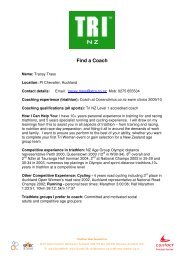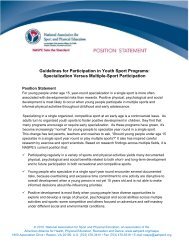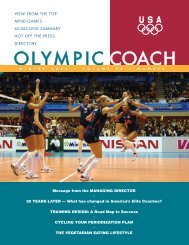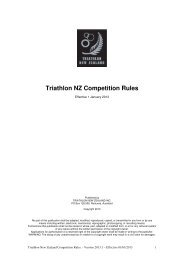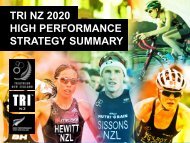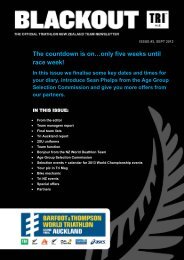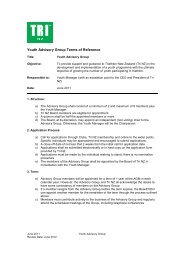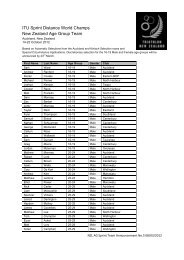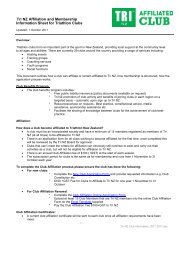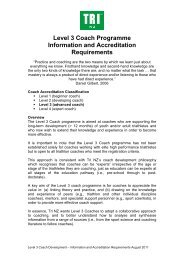The Science of Cycling - IngentaConnect
The Science of Cycling - IngentaConnect
The Science of Cycling - IngentaConnect
Create successful ePaper yourself
Turn your PDF publications into a flip-book with our unique Google optimized e-Paper software.
<strong>The</strong> <strong>Science</strong> <strong>of</strong> <strong>Cycling</strong>: Part 1 303<br />
during the speed/power phase would significantly efficacy <strong>of</strong> a training strategy, it should be<br />
enhance the improvements already made during remembered that the single best predictor <strong>of</strong> a 40km<br />
transition training suggested by Hawley et al. [143] time-trial performance is the average amount <strong>of</strong><br />
Westgarth-Taylor et al. [148] examined the metabolic<br />
power output that can be maintained in 1 hour.<br />
adaptations to the same training protocol and<br />
found that the only changes in metabolism occurred 11. Tapering<br />
at absolute intensities and not relative intensities,<br />
suggesting that the increase in relative intensity durdevelop<br />
a training strategy that blends very hard<br />
To achieve peak performance, the cyclist must<br />
ing the 40km time trial could not be the consequence<br />
<strong>of</strong> an increase in lactate threshold. Weston et al. [149] riding with the correct amount <strong>of</strong> rest and recovery.<br />
examined muscle buffering capacity in response to<br />
A systematic reduction <strong>of</strong> training is a key part <strong>of</strong><br />
the same high-intensity interval training and oband<br />
rate to which training volume, intensity and<br />
preparation for an important competition. <strong>The</strong> extent<br />
served an increase in muscle buffering capacity that<br />
frequency should be reduced during a taper can<br />
was related to the increase in time-trial performance.<br />
seriously affect the cyclist’s race performance.<br />
<strong>The</strong> authors concluded that the increase in relative<br />
Should there be step reductions in training or expoperformance<br />
was due to an increase in muscle bufnential<br />
decays Houmard et al. [150] demonstrated<br />
fering capacity rather than an increase in threshold.<br />
that a 7-day exponential decay in training volume<br />
<strong>The</strong> limited research on interval training in each day or 85% reduction in training volume protrained<br />
cyclists brings light to an overall important duced dramatic improvements in running economy<br />
finding that trained athletes can make significant and 5km race times. Furthermore, MacDougall et<br />
improvements that are measurable in the laboratory. al. [66] employed an exponential taper strategy <strong>of</strong> an<br />
Previously, it has been thought that trained athletes overall 87–88% reduction in training and found a<br />
are unable to demonstrate improvements during 22% increase in endurance performance <strong>of</strong> runners.<br />
training studies because <strong>of</strong> their already high level More specifically, these athletes gained enhanced<br />
<strong>of</strong> fitness. Hence, most <strong>of</strong> the research on training leg-muscle enzyme activity, augmented total blood<br />
has been conducted on individuals <strong>of</strong> low to moder- volume, increased red blood-cell density and greater<br />
ate fitness, suggesting that science knows little muscle-glycogen storage compared with those using<br />
about how to best optimise training in already highly a step-reducing programme. Banister et al. [133]<br />
trained athletes. Laursen and Jenkins [21] highlight demonstrated that an exponential reduction in trainthis<br />
limitation in their review on interval training, ing utilising a reduction in the duration <strong>of</strong> training<br />
and readers are urged to review this paper for greater sessions or the frequency <strong>of</strong> sessions per week to be<br />
discussion on interval training.<br />
extremely effective for improvement <strong>of</strong> Wmax.<br />
In summary, when a rise in training volume no <strong>The</strong>se observations lead to the conclusion that the<br />
longer augments fitness, cyclists employ intervals to exponential decay taper is the superior strategy. It<br />
intensify their training load. Relatively brief but appears that the quicker reduction seems to stimu-<br />
intense sprint training can enhance both glycolytic late quicker recovery from and responses to the<br />
and oxidative enzyme activity, maximum short-term previous training. To be effective, exponential ta-<br />
power output and ˙VO2max. Brief 30-second work pering should include at least 1 day <strong>of</strong>f per week<br />
bouts at 175% <strong>of</strong> peak power followed by 4.5 minutes<br />
with no exercise.<br />
<strong>of</strong> recovery and repeated 12 times has been Trappe et al. [151] showed, in highly trained swim-<br />
found to be nearly as effective for improving 40km mers, that a 21-day taper resulted in neuromuscular<br />
time-trial performance as 4-minute interval training adaptations in type II muscle fibres characterised by<br />
bouts. Moreover, high-intensity intermittent training increased contractile functional properties (peak isoprogrammes<br />
have been effective to increase oxida- metric force, peak power and unloaded shortening<br />
tive enzyme activity in muscle. When examining the velocity). Additionally, swim performance was im-<br />
© 2005 Adis Data Information BV. All rights reserved. Sports Med 2005; 35 (4)



